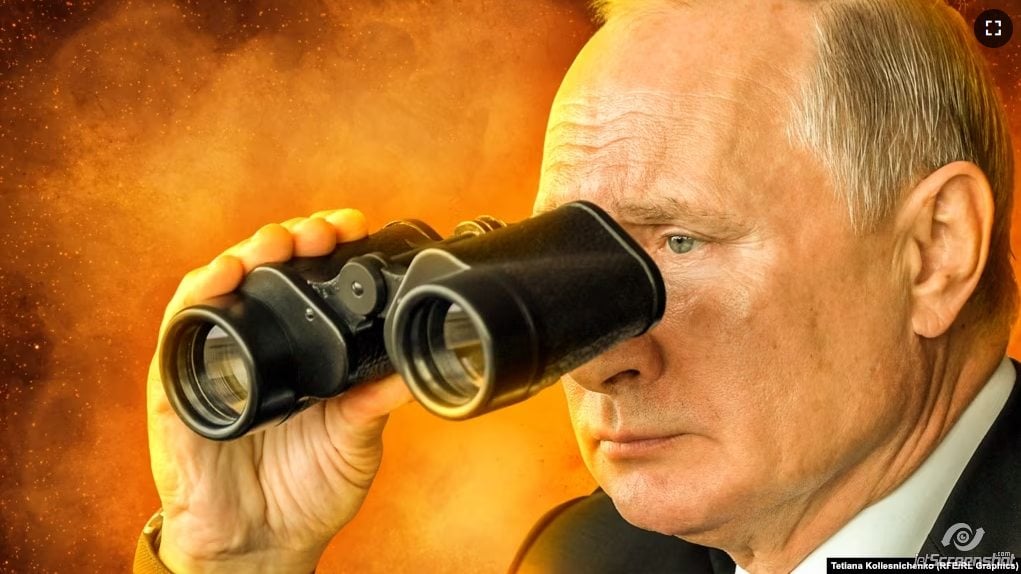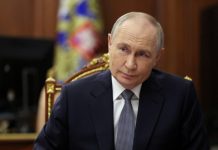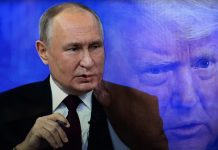By Kseniya Kirillova, for CEPA
The Kremlin’s distorted picture of the world has played a huge role in starting the war and makes it hard to end.
One of Russia’s most serious and least-discussed problems is that under the over-mighty hand of Vladimir Putin, the state’s antennae for receiving and analyzing information has been so badly degraded that it’s blinded itself to events.
This degradation began long before 2014 and is partially responsible for Putin’s initial decision to annex Crimea and start a war in Ukrainian Donbas. It is a deeply dangerous facet of Russian policymaking.
The Kremlin relies on networks of marginal, criminal, and simply inadequate figures to promote its influence abroad and to receive information on developments. This refers not only to support for unpopular leaders, such as former pro-Russian Ukrainian president Viktor Yanukovich — forced to flee by a popular uprising in 2014 — but also certain social movements which were so unpopular that they were discredited in the eyes of local populations.
For example, in Crimea, the Kremlin bet on so-called Cossack organizations, that included former bandits from the 1990s, as well as the descendants of prison guards, checklists, and party bosses, according to the Crimean Tatars. Residents reported that these groups were involved in murders and kidnappings, which didn’t win them any popularity among the peninsula’s population.
Another favored tool of Russian “soft power” was reliance on Russian Orthodox Church elements abroad, especially those that were then considered marginal even within Russia. It is important to note that in the 2000s, religious radicalism was not encouraged in the Russian church. Of course, there were always groups of anti-Western conspiracy theorists who glorified Stalin, hated change, and dreamed of restoring an empire. However, these groups did not constitute the church mainstream and were dimly viewed by the church leadership and educated believers. It took time for them to become mainstream.
Even before this domestic development, however, the Kremlin had placed its bets on radical parties and groups abroad. In Serbia, for example, this was the neo-fascist Serbian Radical Party, and then the Zavetniki party that emerged from it. In Ukraine, the Orthodox brotherhoods and the People’s Cathedral organization, which at that time had just begun to gain strength within the Russian Orthodox Church, were considered the most pro-Russian. In December 2013, the chairman of this organization, Igor Druz, organized a religious procession in Kyiv against “eurosodomy,” as he dubbed the Ukrainian desire for an association agreement with the EU.
But while figures like Druz might be extreme, they were also useful. People with similar views began to be used by Kremlin analysts and intelligence agencies not only as agents of influence to pursue the Kremlin’s ends but also as sources of information about events in their countries. It is entirely possible that their inadequate reports are also the basis for the propaganda myths of 2014 according to which “Ukrainian nazis on orders from the USA and Eurosodom will destroy the Russian-speaking population of Donbas,” as Druz phrased it.
It was likewise a myth that the population of Donbas was somehow “ready to take up arms against the Kyiv regime,” and that a full-scale civil war in Ukraine was unavoidable. In fact, such views were shared only by an extremely narrow stratum of ideological marginals. Even Druz stated that at first, “few people among Russian official authorities understood what was happening,” that is, even in Moscow they didn’t want to listen to his fantasies.
But the situation later changed dramatically. Outcasts were welcomed to the mainstream, not only abroad, but also in the Russian expert community. Russian policy began to respond to these imagined events, Russian organizations including the intelligence agencies began to manufacture evidence of nonexistent events, and foreign and defense policies began to respond in kind. There is a clear line between these developments and Russia’s embrace of wars of aggression.
A frequenter of Russian propaganda TV shows, and former leading researcher at the Russian Institute for Strategic Studies (RISS), Aleksandr Sytin was fired at the beginning of 2015. He then began to detail allegations against his former employer. He said that the-then director of the Institute, former General of the SVR Leonid Reshetnikov, was overcome by religious White Guard ideas, which led the organization to argue at length that Ukraine was an artificially created failed state.
“This position was mixed with extreme, very emotional anti-Westernism,” Sytin said. “It was based on the thesis that European and Russian civilizations have opposite historical missions: the European puts man at the center of its value system while the Russian puts God first.” In Sytin’s account, these were precisely the people who lobbied for the decision to annex Crimea and unleash a war in Donbas in 2014.
Confirmation can be found on the RISS website content for 2013-2014. In particular, at the height of the Euromaidan revolt in February 2014, an interview with a marginal Finnish figure, Johan Beckman, described as a political scientist, and known for his collaboration with the radical ultra-Orthodox portal Russian People’s Line, appeared on the Institute’s website. In an interview with RISS, Beckman claimed that the Euromaidan was “financed by Western intelligence agencies” and was “a fascist occupation of streets and buildings.”
Even earlier, at the end of December 2013, the Institute published a man called Eduard Popov, termed a Ukraine specialist, who argued that the Maidan would lead to a split in Ukraine, and “the leaders of the new Orange Revolution are counterparties of the West.”
RISS is not some marginal organization howling into the wilderness — it is directly subordinate to the Presidential Administration, and previously fell under the jurisdiction of the foreign intelligence service, the SVR. Its job in persuading public opinion is marginal; RISS informs the Russian administrative elite.
There is more evidence, much more. For example, in 2018 on the Military Thought website, which is close to the Ministry of Defense, the analysis section published an article reporting that “open preparations for NATO and US intervention in Russia were underway.”
This was the work of a global, satanic elite mafia, the author explained, “with the goal of gaining total control of the planet and humankind.” It was a theme regularly echoed on the site.
Meanwhile, the Russian president’s brainchild, the Valdai Discussion Club of intellectual figures, not only failed to resist these lurid arguments, they too offered ideological support to the war hysteria and ultimately the full-scale invasion.
There is no reason to hope for improvement. Even pro-Kremlin experts predict further archaization of Russia, noting that economic degradation and the de-emancipation of certain social groups should be expected. The most serious consequence of this trend is the impossibility of conducting constructive negotiations with the Kremlin. Russia’s rulers, as has repeatedly been noted, inhabit an illusion.
By Kseniya Kirillova, for CEPA
Kseniya Kirillova is an analyst focused on Russian society, mentality, propaganda, and foreign policy. The author of numerous articles for the Jamestown Foundation, she has also written for the Atlantic Council, Stratfor, and others.
Europe’s Edge is CEPA’s online journal covering critical topics on the foreign policy docket across Europe and North America. All opinions are those of the author and do not necessarily represent the position or views of the institutions they represent or the Center for European Policy Analysis.





